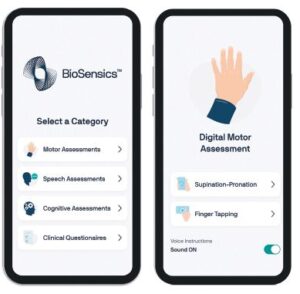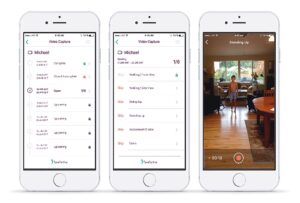
Can Wearables and Smartphones Make Clinical Trials Better?
By Andrew Zaleski | Thursday, May 9, 2024
5 Second Summary
More research studies and clinical trials are incorporating digital health technologies, such as wearable devices, smartphone apps, and telehealth, to work with participants where they are. This increases access and could speed up results.

Mindy Leffler created the Duchenne Video Assessment tool.
Mindy Leffler admits that having her son participate in clinical trials for Duchenne muscular dystrophy (DMD) has been both a privilege and a sacrifice.
Her son, Aidan, now a 20-year-old student at the University of Washington in Seattle, participated in several clinical trials starting at 8 years old. She recalls years of missed birthdays, skipped holiday celebrations, and hours spent in transit. For one trial, Mindy and her family flew from Seattle to Vancouver every Wednesday for weekly clinic visits.
It was hard, but they did it to contribute to the search for DMD treatments that might stem the disease progression and, ultimately, find a cure.
“Families like mine have given up literal flesh and blood, sweat and tears, and the one thing we don’t all have, which is time, in pursuit of answers,” Mindy says.
Over the course of this journey, she thought that there must be a better way. That led Mindy, a former information architect, to create the Duchenne Video Assessment. It allows families to use a smartphone or other device to record video of their child performing certain tasks at home and submit that footage to researchers. These videos give researchers valuable data on the child’s functional abilities in a real-world environment and save the family from having to travel to a clinical trial site for functional tests.
Today, more clinical trials are incorporating digital health technology, like Mindy’s video assessment, wearable devices, and telehealth visits. These technologies are improving the experience for clinical trial participants, increasing access to clinical trials, and speeding up research.
Increasing access
Taking time away from work and family and traveling to clinical trial sites are all-too-common barriers to clinical trial participation.
“It really narrows down the pool of people who can participate in clinical trials, which is hugely inequitable. It’s not fair,” says Mindy.
Beyond logistical considerations, members of the neuromuscular disease community may find they do not qualify for a trial as their disease progresses. Many DMD trials, for example, require participants to complete a six-minute walk test.
“As a neuromuscular disease progresses, certain movements often become more challenging, or an individual is unable to do them at all,” says Paul Melmeyer, MDA’s Vice President of Public Policy and Advocacy. “Consequently, they’re locked out of not only one specific clinical trial — they’re locked out of all clinical trials.”
New digital health technologies can reduce or eliminate the visits to clinical trial sites that are commonly required in clinical trials. This increases access to clinical trials, bringing in a more diverse group of participants. Wearable devices, telehealth services, and software tailored to people with mobility challenges can also provide additional outcomes beyond more limited tests, like the ability to walk or run, that make up the endpoints for many trials today.

BioDigit Home uses wearable sensors and a mobile app to collect patient data at home.
Apps and smartphones
Mindy co-created the Duchenne Video Assessment, which she now oversees as Managing Director of Qualitative Research and Psychometrics at Emmes Endpoint Solutions, to address the issues she sees with the typical clinic-based study design. As she shuttled her son to various clinical trials, she wondered why there wasn’t a better way to measure decline or improvement for kids with DMD. After all, her son wasn’t worried about passing a fitness-oriented six-minute walk test — he just wanted to get from the classroom to the cafeteria on his own.
The Duchenne Video Assessment comprises 16 tasks: For younger boys, there are active tasks such as jumping forward; for young men with less function, tasks include eating 10 bites, reaching across a table to flip over a cell phone, pushing buttons on a remote control, and driving a power wheelchair.
Through a HIPAA-compliant app, families can record their child going through each task in as little as 15 minutes. Those videos are then scored by trained, certified physical therapists who can quantify disease progression. The outcome being studied, then, is neither ambulatory nor nonambulatory; instead, it’s a series of movements applicable across the entire functional spectrum of people with DMD.
So far, this video assessment tool has been used in eight clinical trials.
Wearables and digital assessments

Ashkan Vaziri is founder and CEO of BioSensics.
Digital health tools can also capture more objective data, according to Ashkan Vaziri, the founder and CEO of Massachusetts-based BioSensics, which develops wearable devices and digital assessments to help quantify a range of movement in people with amyotrophic lateral sclerosis (ALS), multiple system atrophy (MSA), and other neuromuscular and neurological conditions. The company has created wearables to monitor gait and balance, as well as digital tools to measure speech impairment and fine motor control, all of which have been used in dozens of studies so far.
“The current method of assessing various treatments in clinical trials involves patients visiting the clinic, performing specific tasks such as walking, and receiving a score based on that performance. However, this approach captures only a snapshot of a singular activity,” he says. “These advancements allow for data collection at home, providing real-world data on a regular basis. This enables a more comprehensive evaluation of drug effects, yielding more meaningful insights.”

The Duchenne Video Assessment allows families to record their child performing tasks at home.
Digital health technology also allows studies to recruit nationally instead of only locally or regionally, giving researchers a larger, more diverse pool of participants. Trials that are less accessible and less diverse are less likely to quickly determine whether a new therapy delivers safe, effective treatment.
And because trial sponsors don’t have to coordinate clinic visits, enrollment is streamlined. Faster enrollment leads to faster data collection, which leads to faster drug development, says Ashkan — this, in turn, can lead to quicker answers on whether an experimental drug or therapy works.
Despite their promise, such tools’ use in clinical research is in the early stages. “I believe the percentage of clinical trials that use digital health technologies is still very small,” says Ashkan, although he expects to see significant growth in the use of remote technologies and telehealth in clinical trials in the coming years.
Improving clinical trials

Paul Melmeyer is MDA’s Vice President of Public Policy and Advocacy.
To streamline data collection, MDA’s Neuromuscular Observational Research (MOVR) Data Hub assembles anonymized clinical and genetic information from individual patients across the MDA Care Center Network, creating a trove of data to help researchers.
Improving clinical trial design is a priority for MDA, and it’s an effort that involves getting digital health technology into more clinical trials. MDA has partnered with Mitsubishi Tanabe Pharma for an ALS study in which data collected remotely (using Fitbit and iPad) will be paired with the participants’ MOVR data entered from their clinic visits. This arrangement allows investigators to see how the remotely collected data compares to data collected at the clinic, with the ultimate goal of conducting fully remote studies.
In addition, Paul says MDA regularly communicates with the US Food and Drug Administration (FDA) and biotechnology partners to encourage trial designs that shift away from endpoints that rely on walking tests and motor ability, so studies are more open to people with diminished mobility — and test what is actually important to those living with neuromuscular diseases.
“Digital health technology, wearables, and other innovations have great promise,” Paul says. “If more individuals are eligible to participate, that means the therapy will get to our community that much more quickly.”
Andrew Zaleski is a journalist who lives near Washington, DC, and wrote about living with myotonic dystrophy type 1 (DM1) for GQ magazine.
What to Know About Clinical Trials
If you’re considering a clinical trial, find out how the study is designed and what it requires before you join.
It is important to understand what is involved in a study, including if digital health technology is used, if there are in-person visits, and if visits can be conducted via telehealth. You should also know the potential risks and end goal.
Many trials have a study coordinator who can answer questions and help address barriers to participation.
For more important considerations, read 9 Questions to Ask Before Joining a Clinical Trial.
Next Steps and Useful Resources
- Read about an MDA Ambassador’s experience in a natural history study for limb-girdle muscular dystrophy (LGMD).
- Download Clinical Trials 101 to understand clinical trial types, phases, and more.
- Watch an MDA Community Education webinar on clinical trial research and participation.
- Use MDA’s Clinical Trial Finder to search for studies by condition and other criteria.
- Stay up-to-date on Quest content! Subscribe to Quest Magazine and Newsletter.
TAGS: Clinical Trials, Drug Development, Innovation, MOVR, Research Advances, Technology
TYPE: Featured Article
Disclaimer: No content on this site should ever be used as a substitute for direct medical advice from your doctor or other qualified clinician.




